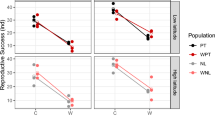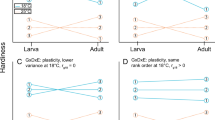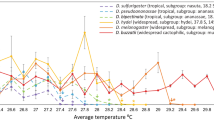Abstract
Global climate is changing rapidly, and the degree to which natural populations respond genetically to these changes is key to predicting ecological responses1,2,3. So far, no study has documented evolutionary changes in the thermal tolerance of natural populations as a response to recent temperature increase. Here, we demonstrate genetic change in the capacity of the water flea Daphnia to tolerate higher temperatures using both a selection experiment and the reconstruction of evolution over a period of forty years derived from a layered dormant egg bank. We observed a genetic increase in thermal tolerance in response to a two-year ambient +4 °C selection treatment and in the genotypes of natural populations from the 1960s and 2000s hatched from lake sediments. This demonstrates that natural populations have evolved increased tolerance to higher temperatures, probably associated with the increased frequency of heat waves over the past decades, and possess the capacity to evolve increased tolerance to future warming.
This is a preview of subscription content, access via your institution
Access options
Subscribe to this journal
Receive 12 print issues and online access
$209.00 per year
only $17.42 per issue
Buy this article
- Purchase on Springer Link
- Instant access to full article PDF
Prices may be subject to local taxes which are calculated during checkout


Similar content being viewed by others
Change history
03 September 2015
In the version of this Letter originally published, in Fig. 1a, the boxplot for the Ambient +4 °C treatment was incorrect. This error has been corrected in the online versions.
References
Parmesan, C. & Yohe, G. A globally coherent fingerprint of climate change impacts across natural systems. Nature 421, 37–42 (2003).
Urban, M. C., De Meester, L., Vellend, M., Stoks, R. & Vanoverbeke, J. A crucial step toward realism: Responses to climate change from an evolving metacommunity perspective. Evol. Appl. 5, 154–167 (2012).
Merilä, J. & Hendry, A. P. Climate change, adaptation, and phenotypic plasticity: The problem and the evidence. Evol. Appl. 7, 1–14 (2014).
IPCC Climate Change 2013: The Physical Science Basis (eds Stocker, T. F. et al.) (Cambridge Univ. Press, 2013).
Bradshaw, W. E. & Holzapfel, C. M. Climate change—evolutionary response to rapid climate change. Science 312, 1477–1478 (2006).
Parmesan, C. Ecological and evolutionary responses to recent climate change. Annu. Rev. Ecol. Evol. Syst. 37, 637–669 (2006).
Davis, M. B., Shaw, R. G. & Etterson, J. R. Evolutionary responses to changing climate. Ecology 86, 1704–1714 (2005).
Gilman, S. E., Urban, M. C., Tewksbury, J., Gilchrist, G. W. & Holt, R. D. A framework for community interactions under climate change. Trends Ecol. Evol. 25, 325–331 (2010).
Easterling, D. R. et al. Climate extremes: Observations, modeling, and impacts. Science 289, 2068–2074 (2000).
Angilletta, M. J. Thermal Adaptation–A Theoretical and Empirical Synthesis (Oxford Univ. Press, 2009).
Pörtner, H. O. & Farrell, A. P. Physiology and climate change. Science 322, 690–692 (2008).
Hoffmann, A. A., Anderson, A. & Hallas, R. Opposing clines for high and low temperature resistance in Drosophila melanogaster. Ecol. Lett. 5, 614–618 (2002).
Helmuth, B., Kingsolver, J. G. & Carrington, E. Biophysics, physiological ecology, and climate change: Does mechanism matter? Annu. Rev. Physiol. 67, 177–201 (2005).
Kristensen, T. N., Loeschcke, V. & Hoffmann, A. A. Can artificially selected phenotypes influence a component of field fitness? Thermal selection and fly performance under thermal extremes. Proc. R. Soc. B 274, 771–778 (2007).
Huey, R. B. et al. Predicting organismal vulnerability to climate warming: Roles of behaviour, physiology and adaptation. Phil. Trans. R. Soc. B 367, 1665–1679 (2012).
Chown, S. L. et al. Adapting to climate change: A perspective from evolutionary physiology. Clim. Res. 43, 3–15 (2010).
Lampert, W. Daphnia: Development of a Model Organism in Ecology and Evolution Vol. 21 (International Ecology Institute, 2011).
Frisch, D. et al. A millennial-scale chronicle of evolutionary responses to cultural eutrophication in Daphnia. Ecol. Lett. 17, 360–368 (2014).
Cousyn, C. et al. Rapid, local adaptation of zooplankton behavior to changes in predation pressure in the absence of neutral genetic changes. Proc. Natl Acad. Sci. USA 98, 6256–6260 (2001).
Decaestecker, E. et al. Host-parasite ‘Red Queen’ dynamics archived in pond sediment. Nature 450, 870–873 (2007).
Franks, S. J., Sim, S. & Weis, A. E. Rapid evolution of flowering time by an annual plant in response to a climate fluctuation. Proc. Natl Acad. Sci. USA 104, 1278–1282 (2007).
Franks, S. J., Weber, J. J. & Aitken, S. N. Evolutionary and plastic responses to climate change in terrestrial plant populations. Evol. Appl. 7, 123–139 (2014).
Mitchell, S. E. & Lampert, W. Temperature adaptation in a geographically widespread zooplankter, Daphnia magna. J. Evol. Biol. 13, 371–382 (2000).
Yampolsky, L. Y., Schaer, T. M. M. & Ebert, D. Adaptive phenotypic plasticity and local adaptation for temperature tolerance in freshwater zooplankton. Proc. R. Soc. B 281, 20132744 (2013).
Palumbi, S. R., Barshis, D. J., Traylor-Knowles, N. & Bay, R. A. Mechanisms of reef coral resistance to future climate change. Science 344, 895–898 (2014).
van Asch, M., Salis, L., Holleman, L. J., van Lith, B. & Visser, M. E. Evolutionary response of the egg hatching date of a herbivorous insect under climate change. Nature Clim. Change 3, 244–248 (2013).
Historic Station Data (Met Office, 2012); http://www.metoffice.gov.uk/climate/uk/stationdata
Hairston, N. G. Jr et al. Rapid evolution revealed by dormant eggs. Nature 401, 446 (1999).
Brakefield, P. M. Artificial selection and the development of ecologically relevant phenotypes. Ecology 84, 1661–1671 (2003).
Van Doorslaer, W. et al. Local adaptation to higher temperatures reduces immigration success of genotypes from a warmer region in the water flea Daphnia. Glob. Change Biol. 15, 3046–3055 (2009).
Ezard, T. H. G., Cote, S. D. & Pelletier, F. Eco-evolutionary dynamics: Disentangling phenotypic, environmental and population fluctuations. Phil. Trans. R. Soc. B 364, 1491–1498 (2009).
Schoener, T. W. The newest synthesis: Understanding the interplay of evolutionary and ecological dynamics. Science 331, 426–429 (2011).
Dillon, M. E., Wang, G. & Huey, R. B. Global metabolic impacts of recent climate warming. Nature 467, 704–706 (2010).
Bellard, C., Bertelsmeier, C., Leadley, P., Thuiller, W. & Courchamp, F. Impacts of climate change on the future of biodiversity. Ecol. Lett. 15, 365–377 (2012).
Acknowledgements
A.N.G. is supported by the Institute for the Promotion of Innovation through Science and Technology in Flanders (IWT Vlaanderen). The mesocosm experiment at Liverpool was supported by the EU IP project EUROLIMPACS (EU Contract No. GOCE-CT-2003-505540), and the overall study was supported by KU Leuven Research Fund Excellence Center financing PF/2010/07 and by ERA-Net BiodivERsA project TIPPINGPOND, nationally funded by Belspo. T. H. Haileselasie kindly helped with the analysis of genetic differentiation using microsatellite markers. We thank the National Trust for access to Felbrigg Hall Lake and thanks also to R. Huey and T. Ceulemans for valuable comments on an earlier version of the manuscript.
Author information
Authors and Affiliations
Contributions
L.D.M. and A.N.G. designed the overall research project. B.M., D.A. and H.F. designed the climate experiment and W.V.D. and L.D.M. developed the evolutionary selection module. W.V.D. and H.F. carried out the selection experiment. T.A.D. and C.D.S. took and analysed the sediment cores and carried out palaeolimnological analyses. A.N.G., L.D.M. and J.V. developed the resurrection ecology experiment. A.N.G. hatched the eggs and carried out the standardized CTMax experiments. A.N.G. together with J.V. and B.V. carried out the statistical analyses with input from L.D.M. A.N.G. and L.D.M. wrote the manuscript. All authors contributed to editing the manuscript.
Corresponding author
Ethics declarations
Competing interests
The authors declare no competing financial interests.
Supplementary information
Rights and permissions
About this article
Cite this article
Geerts, A., Vanoverbeke, J., Vanschoenwinkel, B. et al. Rapid evolution of thermal tolerance in the water flea Daphnia. Nature Clim Change 5, 665–668 (2015). https://doi.org/10.1038/nclimate2628
Received:
Accepted:
Published:
Issue Date:
DOI: https://doi.org/10.1038/nclimate2628
This article is cited by
-
Historical DNA reveals climate adaptation in an endangered songbird
Nature Climate Change (2023)
-
Can laboratory-reared aphid populations reflect the thermal performance of field populations in studies on pest science and climate change biology?
Journal of Pest Science (2023)
-
Can long-term salinity acclimation eliminate the inhibitory effect of salinization on anti-predation defense of Daphnia?
Environmental Science and Pollution Research (2023)
-
Reconstruction of 100-year dynamics in Daphnia spawning activity revealed by sedimentary DNA
Scientific Reports (2022)
-
Interactive Effects of Warming and Pollutants on Marine and Freshwater Invertebrates
Current Pollution Reports (2022)



